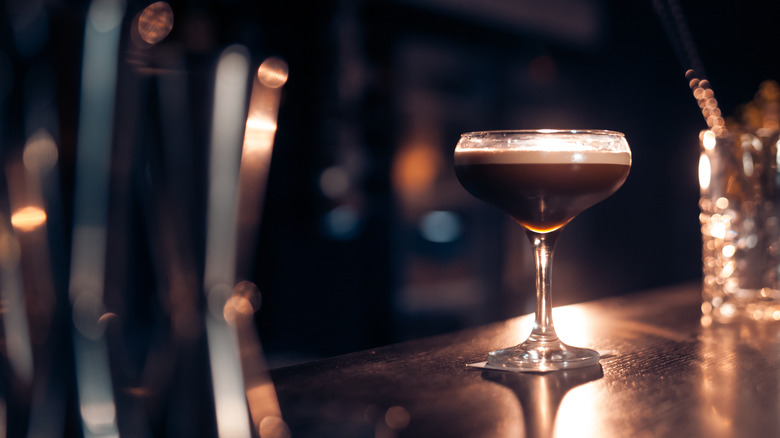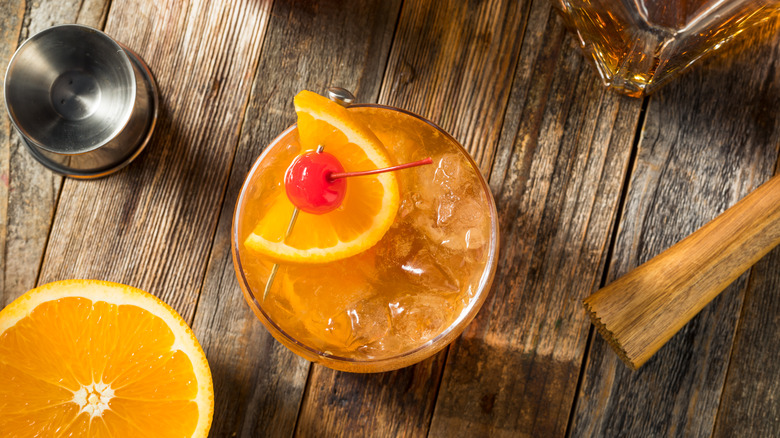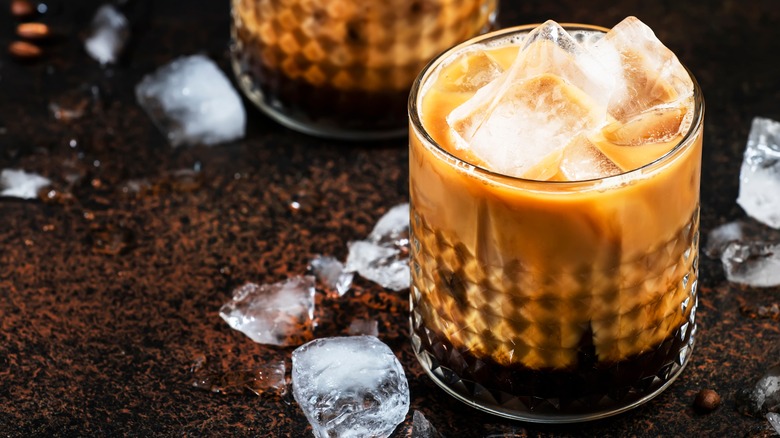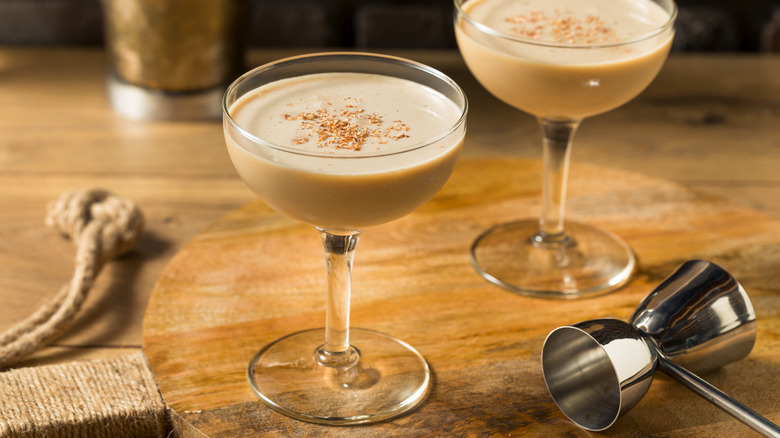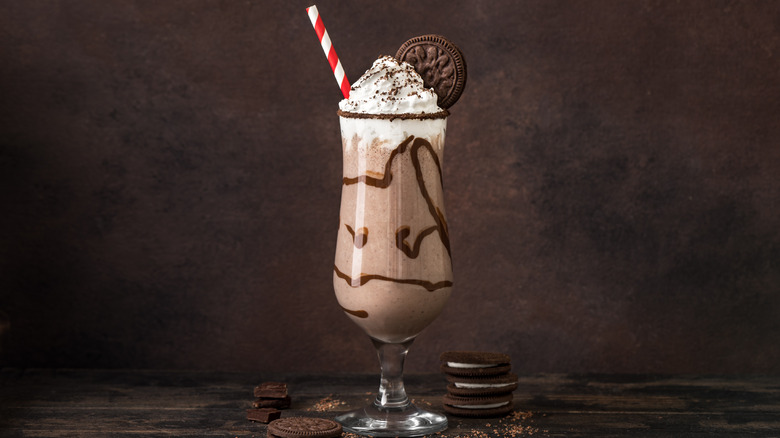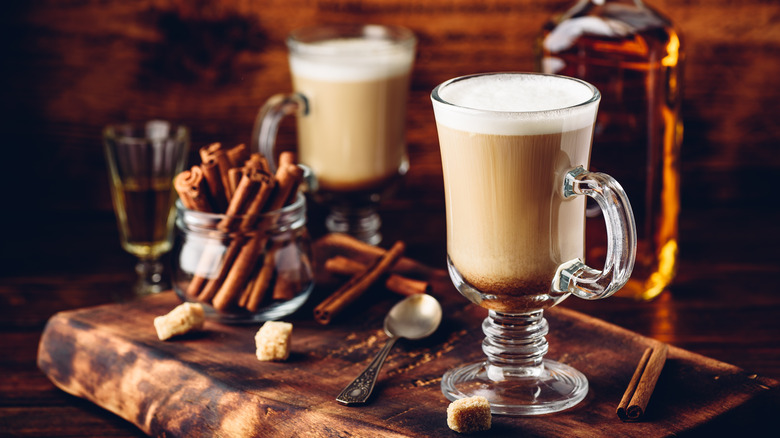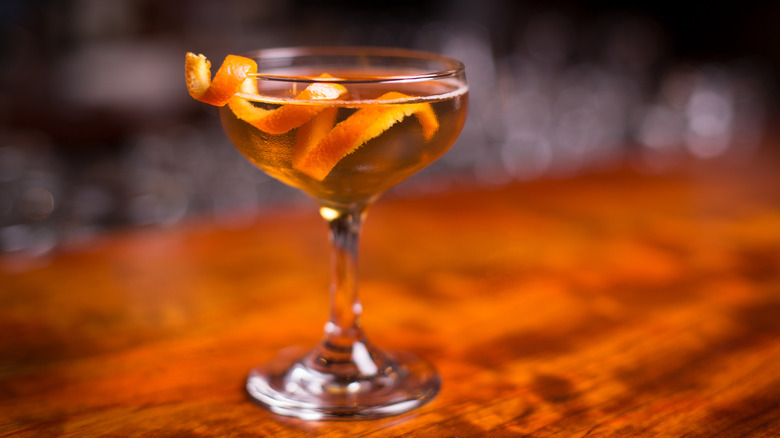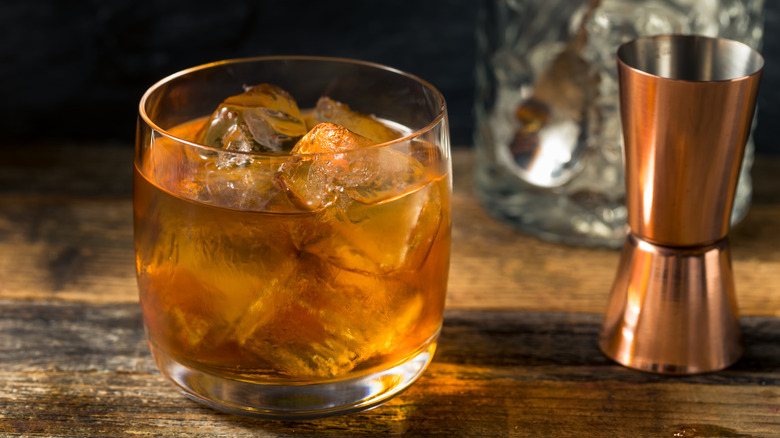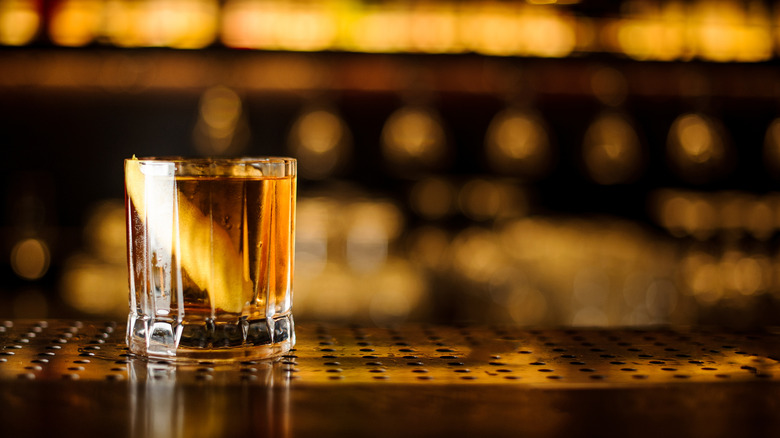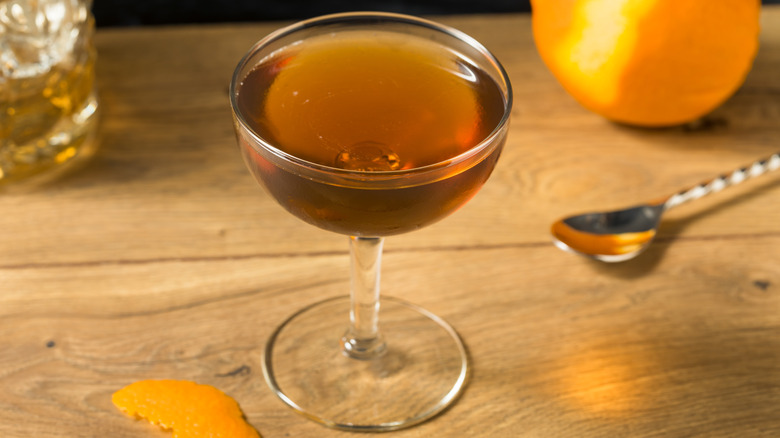The Absolute Best After-Dinner Cocktails
Drinking and food can have a non-complementary relationship. However, when consumed together thoughtfully and responsibly, a delightful symbiotic combination can be reached, enjoyed, and indulged in. As a meal comes to a close and the final sip of your glass of wine or pint of beer is taken, diving headfirst into another may not be the best decision in terms of both your digestion or possible inebriation.
While aperitifs are best enjoyed prior to a meal to stimulate appetite, digestifs, per VinePair, are for afterward, meant to bring your satisfied appetite across its finish line and into recovery. The reason for digestifs effectiveness comes from the human body perceiving their taste to be harmful, which springs the digestive system into action in order to dispel everything inside. This bitter, robust flavor causes some people to be turned off by sipping digestifs on their own. Luckily, there are plenty of cocktails out there that are both beneficial to digestion as well as delicious.
Sometimes, you may not find yourself in need of a digestif cocktail and just want to enjoy another round but are not looking to repeat yourself. Instead, you may be looking for a more saccharine, decadent cocktail that can sit alongside a dessert or even take the place of one. Dessert cocktails can accomplish the need for trying something new, satisfying your post-meal sweet tooth, moving the night along or bringing it to a close. No matter, here are a variety of cocktails that will help fulfill whatever it is you're looking for after dinner.
Espresso Martini
Of all the modern classics born out of the cocktail renaissance, the espresso martini is undoubtedly the king. The espresso martini was invented by a revolutionary of the mixology boom, Dick Bradsell. The British bartending guru became an icon throughout the 1980s across London, according to Taste Cocktails.
Legend has it a model sat down at a bar called Fred's Club and asked Bradsell for a drink that would help wake her up. Pulling a shot of espresso from the machine next to the bar and shaking it with vodka, coffee liqueur and sugar, the "Vodka Espresso" was born. The cocktail then became known as the "Pharmaceutical Stimulant" before donning the iconic name it is globally known by today.
The espresso martini is obviously dominated by rich coffee flavor, which is perfect for the end of a meal. Instead of sipping on regular coffee or espresso plain, why not get that needed zip in the form of a delicious, classy cocktail? The presence of vodka only acts as a vehicle for an alcoholic bite, as the spirit is usually flavorless in this application, and the coffee liqueur is the perfect boozy supporting cast to the dark, sharp espresso.
The best part about this drink may be its simplicity. Not only has the cocktail reached a level of popularity that has made it available at almost every bar, the ingredients are so accessible that you can make the drink yourself at home anytime you like — not only after dinner.
Wisconsin Old Fashioned
Speaking of icons, the Old Fashioned is as iconic a cocktail as there is. The simple combination of sugar, bitters, and whiskey dates all the way back to the year 1880, according to Thrillist. The Old Fashioned has inspired countless variations containing different spirits to different types of bitters and sugars. The Wisconsin Old Fashioned, however, is one variation perfectly suited to wind down an evening.
Although the Old Fashioned is widely experimented, Wisconsinites are very particular with the cocktail of their state's namesake, as Milwaukee Public Radio notes. Traditional Old Fashioneds call for either bourbon or rye whiskey. The Wisconsin version, however, calls for brandy. Additionally, instead of a traditional orange twist, this cocktail calls for muddled fruit, particularly orange slices and brandied cherries, as well as a topping of lemon lime or club soda.
While purists may dismiss the Wisconsin Old Fashioned, the cocktail is as well established as any other. Per Liquor.com, it was born in the 1890s as the original Old Fashioned was gaining popularity throughout the Midwest. So, too, was brandy, as German immigrants settling in the region brought the taste with them from their European background. Whiskey was replaced with the wine distilled spirit and as Prohibition rolled in, less-than-ideal-tasting booze needed to be covered up. The muddling of fresh fruit and spritzing of sodas helped do so and the Wisconsin Old Fashioned was born.
The sweetness of the brandy is perfect for after-dinner sipping and the accompaniment of fresh fruit and light fizziness from the soda is like a summer dessert in a glass. This cocktail is both mellowing and refreshing and is another one you can make right at home.
White Russian
The White Russian can best be described as a combination of vices. This sweet cocktail made up of vodka, coffee liqueur, and cream will satisfy your craving for booze, sugar, caffeine or all of the above.
According to Chilled, the White Russian was invented in 1949 by a Belgian bartender named Gustave Tops working at the Hotel Metropole in Brussels. The drink was mixed by Tops to honor the U.S. Ambassador to Luxembourg, Perle Mesta. Tops simply added cream to the already established Black Russian and the milky cocktail fit in well with the many similar cocktails popular at the time.
However, the popularity of this particular cocktail nearly fizzled out to its extinction. That is until the cult classic film "The Big Lebowski” practically cast the White Russian in a supporting role. The film's main character drinks the cocktail a total of nine times. As The New York Times explains, "The Big Lebowski” was originally a flop but later found its audience; the film's delayed explosion in popularity was accompanied by the cocktail's and the White Russian was revived and has since sustained.
In fact, variations on the White Russian have come about, including a White Mexican, which uses Horchata instead of cream, and the Dirty Russian which swaps in chocolate milk. Whether you're trying the original or an inspired take, the White Russian is a cocktail to be sipped on only with the sweet easygoing-ness the dude himself abides.
Brandy Alexander
The brandy Alexander's history is not totally certain. Some believe it is named after Alexander II, the Russian tsar, and others believe it to be after King George V's daughter, per Bar & Restaurant. The most likely origin, however, is attributed to the cocktail's most widely attributed creator, Troy Alexander. The brandy Alexander, however, is a riff on the classic, gin-based cocktail, the Alexander. Troy Alexander mixed the first brandy variation while working at the legendary NYC bar Rector's in the early 1900s. The brandy Alexander has since become an all-time great, even earning the title as John Lennon's favorite cocktail (per The Georgetowner) and has its own holiday every January 31.
The brandy Alexander is a combination of brandy, cream, and crème de cacao, or chocolate liqueur. The drink is shaken and strained neat into a martini class and typically garnished with freshly grated nutmeg. For those who are fans of the White Russian, the brandy Alexander is a boozier, more robust cocktail that will pack a punch but also bring comfort and ease.
Other variations of the original gin-based Alexander include ones made with bourbon and vodka, but the brandy Alexander is your best choice for sipping after a meal. It's sweet, chocolatey, creamy, and boozy and a mighty fine touch of class to close out an evening.
Mudslide
In regards to dessert drinks, it doesn't get any more decadent or indulgent than the mudslide. This variation on the White Russian contains the addition of Irish cream. According to A Couple Cooks, however, the mudslides commonly known today are not the original, but they're better. The more popular variation on the mudslide replaces the heavy cream with vanilla ice cream. Even more, mudslides are typically served with chocolate syrup-dipped glassware. Yes, it's an ice cream sundae for adults.
Per Wine Enthusiast Magazine, the original mudslide was invented in the 1970s at a bar called Wreck on Grand Cayman. Apparently, an order was placed for a White Russian, but the bar was out of cream. Bailey's Irish Cream took its place and the Mudslide was born. As popularity grew, ice cream became a player and the cocktail's popularity grew even further. The boozy milkshake is the quintessential dessert cocktail. The alcohol is basically lost within the intense flavors of coffee, nuttiness, chocolate, and vanilla ice cream. After finishing dinner, the mudslide is the perfect cherry on top, that is if you saved enough room for one.
Irish Coffee
This after-dinner cocktail may be the most simple, but that's the reason why it's so good. This drink made up of just coffee, Irish whiskey, and sugar is a delicious and easy way to give your spark of caffeine after dinner a little extra zip. Because Irish whiskey is more delicate than other dark spirits, its bite is subdued by the coffee and sugar. What is left behind is its sweet, honey flavor that boosts your coffee's flavor in addition to empowering it.
San Francisco (specifically The Buena Vista) introduced America to Irish coffee, per SF Travel. However, as KQED explains, the inventor of the drink was actually a man named Joe Sheridan, an airport chef at Foynes Airport in Limerick, Ireland. After a delayed flight left passengers stranded, Sheridan helped warm them up with a little something extra.
Sheridan took the drink with him to the Shannon Airport, and the simple cocktail's popularity spread also. Sure, it was not some heavenly revelation that resulted in the Irish coffee, but the simple combination of Irish whiskey and coffee on a cold, rainy night probably did well to make those passengers' evenings a little bit better.
Like many of the cocktails on this list, the Irish coffee is super easy to make and definitely worth trying, after dinner or whenever you like — even when it's not cold.
After Supper
Suitably named for this list, the After Supper is another three-ingredient cocktail featuring brandy, apricot brandy to be exact, per Steve the Bartender. A sweeter version of the already sweeter spirit is combined with orange liqueur and fresh lemon juice to create an easy-sipping, bright, fruity cocktail, perfect for rounding out a meal in the warmer months.
There are a variety of orange liqueurs out there. In most drinks, the kind you use will not make too big a difference in the finished product, but the best one to use in the After Supper, according to Steve the Bartender, is dry Curaçao. Other orange liqueurs like triple-sec are very sweet and if combined with the apricot brandy, the sweetness could be overpowering. Instead, a dry Curaçao such as that by Pierre Ferrand works perfect for this drink as it is drier and more spice-driven, helping to balance out the brandy and allowing the lemon juice to cut everything equally. Served in a coupe glass and garnished simply with a twist of orange, this drink is another classy touch at the end of the night.
The recipe for the After Supper was documented in Harry Craddock's book "The Savoy Cocktail Book," first published in 1930. As Forbes explains, the book was the bartending standard for London bars in the 1930s and this cocktail is an encapsulation of the sophistication it was born out of.
French Connection
This is the first cocktail on our list of after-dinner cocktails to feature cognac. Basically, all cognac is brandy, but not all brandy is cognac, according to Creative Culinary. For a brandy to be classified as a cognac, it must be made with a wine grape grown in the Cognac region of France. Like many other spirits, the cognac you sip comes naturally with a stamp of approval. It is distinctly French and the perfect ingredient for this cocktail of the same name.
While there is very little known about the history and origin of the cocktail, many claim the drink is named after the 1971 film "The French Connection," starring Gene Hackman (via MasterClass). Other than that, there's no other interesting reason to give it a try other than that it is delicious. The French Connection is a combination of cognac and amaretto, a sweet, Italian liqueur. This cocktail is simple and straightforward. Served on the rocks and with a twist of orange, the French Connection is another easy-sipping after-dinner drink fit for all year-round.
Rusty Nail
This cocktail is one of legends, just ask any member of the Rat Pack, per Make Me a Cocktail. The Rusty Nail is a combination of Scotch whisky, Drambuie, and bitters. Drambuie, as The Spruce Eats explains, is a Scotch-based liqueur flavored with honey, herbs, and spices — the exact ingredients and amounts of which remain unknown for sure. Drambuie is sweet and complex. The taste of whiskey is the driving force, but the bite is held tame by smooth, spiced honey. It is the perfect sidekick to the straight Scotch mixed with it in a Rusty Nail.
Along with the bitters, the robust presence of whiskey packs a punch in the Rusty Nail but is not overpowering. Not to mention, Drambuie and Scotch are both considered digestifs, so not only is this after-dinner cocktail delightfully punchy, your stomach will thank you as well.
According to Concrete Playground, the origin of the name "rusty nail" has a few different accounts of folklore, each having to do with explaining the "nail" part of the name. One explanation is that a bartender actually mixed the drink with a nail in it. The outlet explains, though, the most likely reason is the color of the drink, thanks to the Drambuie. However, whichever is the truth, the Rusty Nail is a classic cocktail fit for bars and your home alike. It was the signature cocktail of Frank Sinatra and his entourage, which is a reason to give it a try in and of itself.
Tipperary
According to Wine Enthusiast Magazine, the Tipperary features sweet vermouth, green chartreuse, sugar, orange bitters, and, of course, Irish whiskey. The cocktail first appeared in Hugo R. Ensslin's 1917 book "Recipes for Mixed Drinks." In the book, he wrote that he first mixed the drink for a customer who walked into his bar humming "It's a Long Road to Tipperary" and asked for a drink.
The main reason a Tipperary is great for after dinner is because of its incorporation of green chartreuse. Per Luxury Defined, the first recording of the French digestif dates all the way back to 1605 and was a gift to Chartrusian monks by a French soldier. The liqueur is a combination of distilled alcohol and 130 different herbs, but the exact recipe is still kept secret.
Its presence in this cocktail is to balance out the sweet vermouth, or maybe vice versa. Chartreuse, like most digestifs, is very bitter. Along with the sweet vermouth and Irish whiskey, this cocktail checks off all the taste buds. While most cocktails including Irish whiskey are served on the rocks in lowball glasses, the Tipperary is served up in a martini glass and with a twist of orange. This cocktail is elegant and an all-time classic for good reason. Although not all the ingredients are exactly home-bar staples, the Tipperary is definitely worth a try. Your mouth and your after-dinner stomach will thank you.

